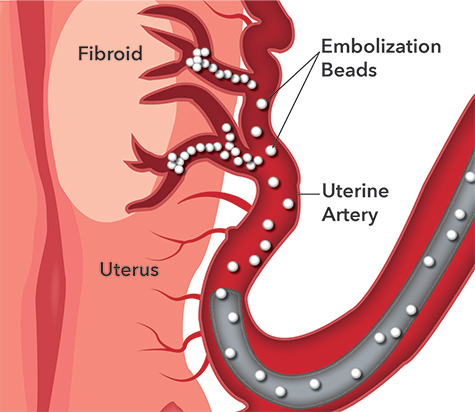
Vascular & Interventional Radiology
Uterine Fibroid Embolization (UFE)
What are Uterine Fibroids?
Uterine fibroids are the most common tumor within the female reproductive system. They are benign, non-cancerous growths in the muscle tissue of the uterus and location, shape and size may vary. The fibroid may present inside the uterus, on the outer surface, within the wall or attached to it and the size may vary from less than an inch to more than 6 inches in diameter.
Who is at Risk?
All women are at potential risk of developing uterine fibroids. Studies show uterine fibroids develop in 20-40% of women over the age of 35. While uterine fibroids have been known to occur in women under the age of 35, the majority occur in women between the ages of 35 and 54.
How are Uterine Fibroids discovered?
The majority of women with uterine fibroids don’t have any noticeable symptoms and the fibroid is only discovered during routine pelvic exams. Others may notice some of the following symptoms:
- Excessive and prolonged menstrual bleeding
- Constipation or bloating
- Pelvic pressure
- Frequent urination
- Pain or pressure in the back of the legs
- Anemia / low hemoglobin
- Pain during sexual intercourse
What to expect during a UFE procedure:
The procedure is performed in Interventional Radiology. You will be awake for the procedure but you will receive medicine to block pain and to make you feel relaxed. The doctor will then insert a thin tube called a “catheter” into an artery in your leg or arm. The doctor will then use special dye and x-ray to show the blood supply to the fibroid. Next tiny beads will be injected into the artery to block the blood flow.
What to expect after a UFE procedure?
You will experience some lower belly pain or cramping after the procedure. Pain medications will be prescribed as needed to alleviate discomfort. Some women have vaginal discharge or bleeding after the procedure. Others may experience stomach flu like symptoms and your doctor can prescribe medicine to treat them.
Related: Fibroid Embolization Mapping
Additional References
Many women diagnosed with Uterine Fibroids are unaware of their treatment options. We want you to make an informed decision about your health and your future.
Society of Interventional Radiology Information for Patients:
RadiologyInfo.org Information for Patients:
U.S. Department of Health and Human Services, Office of Women’s Health:
Resources:
